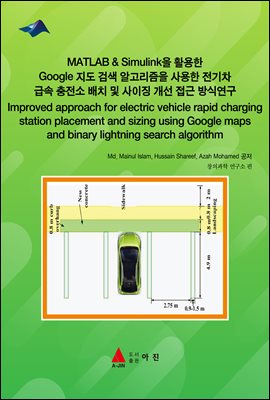
MATLAB & Simulink을 활용한 Google 지도 검색 알고리즘을 사용한 전기차 급속 충전소 배치 및 사이징 개선 접근 방식연구(Improved approach for e
- 저자Md. Mainul Islam, Hussain Shareef, Azah Mohamed 저
- 출판사아진
- 출판일2020-07-14
- 등록일2020-12-21
- SNS공유


- 파일포맷PDF
- 파일크기9MB
- 공급사YES24
-
지원기기
PC
PHONE
TABLET
프로그램 수동설치
전자책 프로그램 수동설치 안내
아이폰, 아이패드, 안드로이드폰, 태블릿,
보유 1, 대출 0,
예약 0, 누적대출 9, 누적예약 0
책소개
The electric vehicle (EV) is considered a premium solution to global warming andvarious types of pollution. Nonetheless, a key concern is the recharging of EV
batteries. Therefore, this study proposes a novel approach that considers the costs
of transportation loss, buildup, and substation energy loss and that incorporates
harmonic power loss into optimal rapid charging station (RCS) planning. A novel
optimization technique, called binary lightning search algorithm (BLSA), is
proposed to solve the optimization problem. BLSA is also applied to a conventional
RCS planning method. A comprehensive analysis is conducted to assess the
performance of the two RCS planning methods by using the IEEE 34-bus test
system as the power grid. The comparative studies show that the proposed BLSA is
better than other optimization techniques. The daily total cost in RCS planning of
the proposed method, including harmonic power loss, decreases by 10% compared
with that of the conventional method.
목차
제 1편 : SIMULINK 기본편1.1 SIMULINK의 시작 1
블록의 연결 5
블록 파라미터의 설정 7
시뮬레이션 파라미터 (Configuration Parameters)의 설정 8
시뮬레이션의 수행 9
블록 파라미터의 표시 9
복수 데이터의 표시 11
2.2 동적 시뮬레이션 13
이차 미분방정식 17
선형 상태변수 모델 23
DC 모터의 시뮬레이션 24
함수 블록의 사용 29
차분방정식(difference equation)의 모델링 34
Subsystem(부시스템)의 구성 37
제 2편 : 연구논문
Improved approach for electric vehicle rapid charging station
placement and sizing using Google maps and binary lightning search
algorithm
1. Introduction 41
2. Problem formulation for optimal RCS planning 43
3. Description of road and power system networks 49
4. Test results and discussion 50
5. Discussion 56
6. Conclusion 57
7. References 59

















